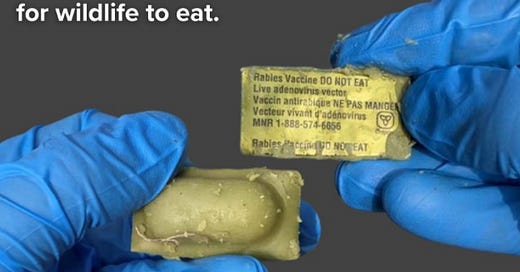Over 350k Rabies Packets Were Dropped in Vermont. What if You Come Across One?
While the vaccine is considered safe for humans, pets, and non-target wildlife, handling baits is discouraged.
In an effort to curb the spread of rabies in Vermont and prevent it from moving north across the Canadian border, the U.S. Department of Agriculture (USDA), in partnership with Vermont state agencies, launched a large-scale oral rabies vaccine bait drop in May. The initiative distributed approximately 350,000 vaccine-laced bait packets across multiple counties by low-flying aircraft and hand placement in more populated areas.
What Was Dropped?
Each bait consists of a quarter-sized blister pack containing the ONRAB® oral rabies vaccine, encased in a sweet-smelling green waxy coating that attracts raccoons and skunks—the primary rabies carriers in Vermont. The goal is to immunize these wild animals and create a barrier to rabies transmission in both rural and suburban areas.
The baits are clearly labeled in both English and French with a message indicating that they are a rabies vaccine and not to be consumed by humans.
Is It Safe?
According to health officials and multiple scientific studies, the vaccine is safe for humans, pets, and non-target wildlife, although it is still classified as “experimental.”
The vaccine does not contain live rabies virus and cannot cause rabies, even if accidentally ingested. Since the USDA began these drops in the 1990s, millions of baits have been deployed across the U.S. and Canada with no reported human illness.
That said, handling baits is discouraged. If found, residents should leave the bait where it is so wildlife can consume it. If absolutely necessary to move a bait—say, if it’s in a place where children or pets play—use gloves or a plastic bag, and wash hands thoroughly afterwards.
If a child brings home a bait or a dog eats one, do not panic, but call the Vermont Rabies Hotline at 1-800-4-RABIES (1-800-472-2437) to report the incident and receive guidance.
Where Are the Baits Being Dropped?
Baits are being distributed across much of northern and central Vermont, particularly in areas where rabies cases have risen in recent years. Counties and towns involved include:
Addison County (e.g. Vergennes, Bristol)
Caledonia County (e.g. St. Johnsbury, Danville)
Chittenden County (e.g. Burlington, Essex, Milton)
Essex County (e.g. Lunenburg, Concord)
Franklin County (e.g. Swanton, St. Albans)
Grand Isle County (e.g. South Hero, Alburgh)
Lamoille County (e.g. Stowe, Johnson)
Orange County (e.g. Williamstown, Newbury)
Orleans County (e.g. Barton, Glover)
Washington County (e.g. Barre, Montpelier, Northfield, Waterbury)
The bait drop is was expected to take several days via air and up to two weeks for ground crews to complete hand placement. Timing may vary based on weather conditions.
Why This Matters
Rabies is a fatal disease that affects the brain and can infect any mammal, including humans. The virus is typically transmitted through bites or contact with saliva from an infected animal. In recent years, rabies cases have spiked in Vermont, particularly among raccoons and skunks in Franklin, Chittenden, and Caledonia counties. Since 2022, over 90 rabid animals have been identified in those areas.
This effort is part of a broader, international strategy to eradicate rabies in wildlife, which reduces the risk to pets, livestock, and people. Officials stress that while the bait drop is a critical tool, it’s not a standalone solution. Vermonters should:
Vaccinate their pets, especially dogs and cats.
Avoid contact with wild animals, even if they appear friendly.
Seek immediate medical advice if bitten or exposed to animal saliva.
Final Reminders
Don’t touch the bait unless absolutely necessary.
Don’t try to remove bait from your dog’s mouth—you may get bitten.
Call 1-800-4-RABIES with any concerns or questions.
Learn more at HealthVermont.gov/Rabies




